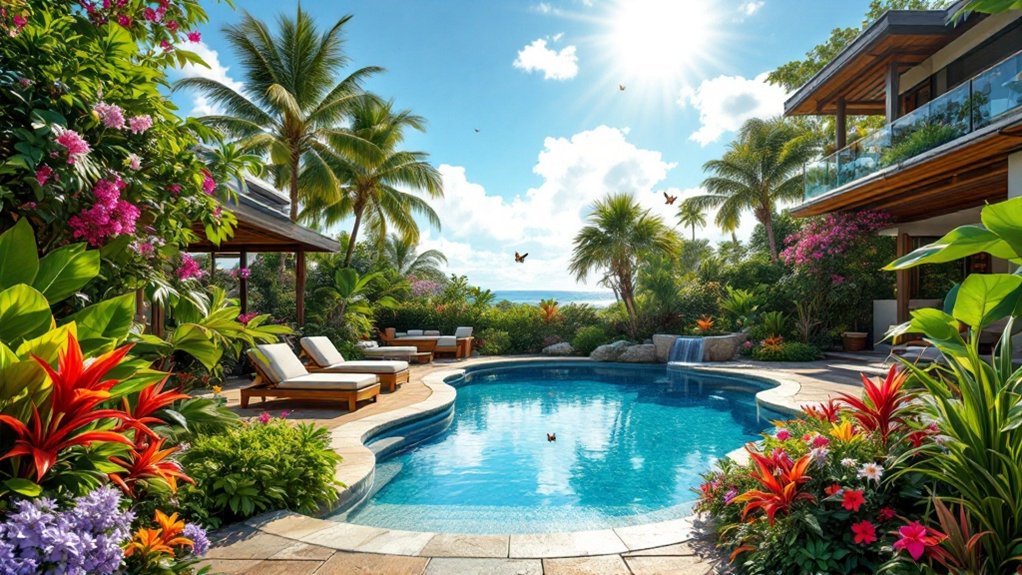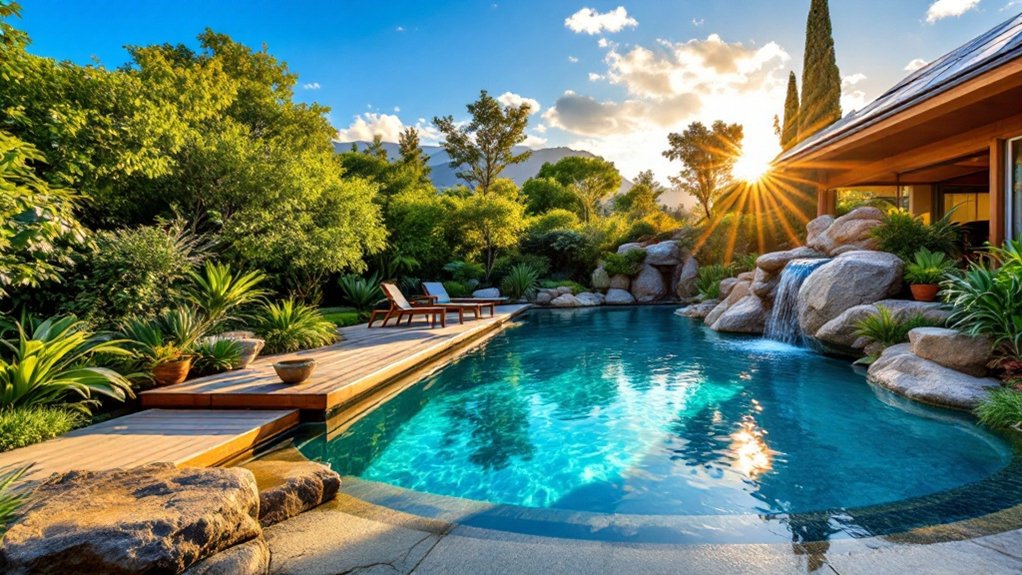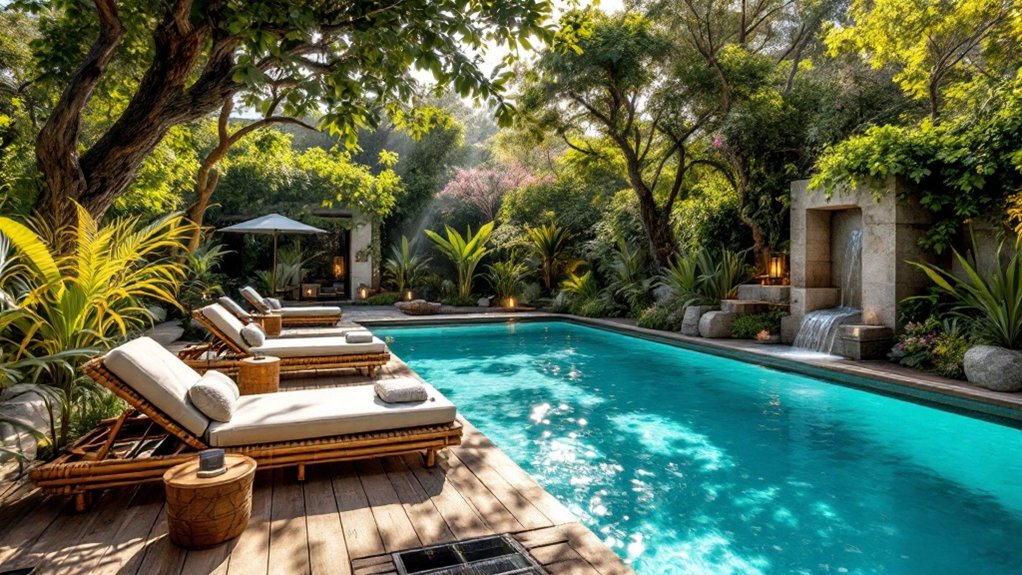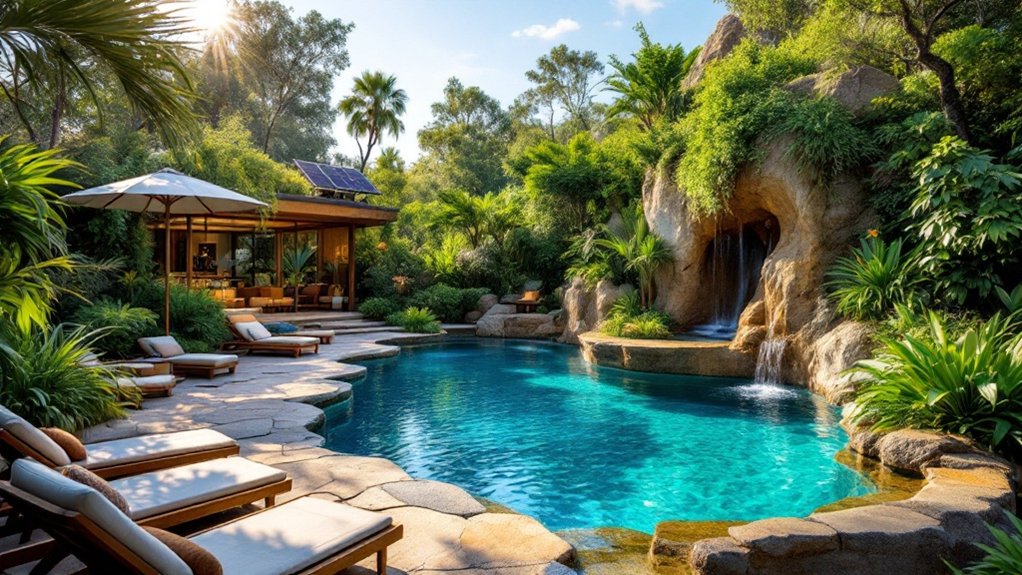Eco-conscious poolside landscaping presents a range of benefits that extend beyond mere aesthetics. By focusing on sustainable practices, such designs promote water conservation and provide habitats for local wildlife. They also minimize chemical usage, enhancing the surrounding environment. Additionally, these landscapes can lower maintenance costs and increase property value. Understanding the full scope of these advantages reveals a compelling case for adopting eco-friendly landscaping practices. What lies beneath the surface of these benefits?
Promotes Water Conservation
While many homeowners seek to enhance their outdoor spaces, eco-conscious poolside landscaping can greatly promote water conservation. By incorporating native plants that require minimal irrigation, homeowners can reduce their water usage considerably. Drought-resistant species thrive in local climates, minimizing the need for excess watering. Additionally, using permeable materials for walkways allows rainwater to seep into the ground, replenishing groundwater supplies. Implementing efficient irrigation systems, such as drip lines or smart timers, further optimizes water use, ensuring that plants receive just the right amount. Rainwater harvesting systems can also be integrated, capturing runoff for poolside landscaping needs. These strategies not only conserve water but also contribute to a sustainable environment, making eco-conscious choices beneficial for both the homeowner and the planet.
Supports Local Wildlife
Eco-conscious poolside landscaping not only elevates the aesthetic appeal of outdoor spaces but also plays an essential role in supporting local wildlife. By incorporating native plants and creating diverse habitats, these landscapes provide food and shelter for various species. Butterfly gardens, for instance, attract pollinators, while native shrubs can offer nesting sites for birds. Additionally, water features, such as ponds or rain gardens, support aquatic life and help maintain local ecosystems. Such environments encourage beneficial insects, which contribute to natural pest control, fostering a balanced ecosystem. Moreover, eco-friendly landscaping practices can enhance biodiversity, ensuring that local flora and fauna thrive. Ultimately, these thoughtful designs create a harmonious relationship between human enjoyment and nature’s preservation.
Reduces Chemical Usage
By prioritizing eco-conscious poolside landscaping, homeowners can considerably reduce chemical usage in their outdoor spaces. This approach emphasizes the use of native plants, which are more resilient and require fewer pesticides or herbicides compared to non-native varieties. By creating a balanced ecosystem, homeowners can support beneficial insects and wildlife that naturally control pests, minimizing the need for chemical interventions. Additionally, implementing organic fertilizers and composting practices enriches the soil without harmful chemicals. The inclusion of permeable materials in landscaping allows for better water filtration and reduces runoff, further decreasing the reliance on chemical treatments. Ultimately, eco-conscious landscaping not only benefits the environment but also promotes a healthier and safer space for families and pets.
Enhances Aesthetic Appeal
Eco-conscious poolside landscaping enhances aesthetic appeal through a thoughtful selection of vibrant plants that attract attention and provide a lush backdrop. The integration of natural materials, such as stone and wood, further complements the outdoor space, creating a harmonious environment. Additionally, sustainable design elements not only elevate the visual impact but also promote ecological balance.
Vibrant Plant Selection
While creating a visually appealing poolside landscape, selecting vibrant plants plays an essential role in enhancing the overall aesthetic. Colorful flowers and lush foliage not only draw attention but also create a sense of tranquility and harmony. Varieties such as hibiscus, bird of paradise, and ornamental grasses can introduce dynamic textures and hues, transforming the area into a lively oasis. Additionally, choosing native plants often guarantees that the landscape remains sustainable and low-maintenance, as these species are well-adapted to local climate conditions. Incorporating a mix of heights and colors can provide visual interest year-round, attracting pollinators and enriching the ecosystem. Ultimately, a thoughtful selection of vibrant plants elevates the poolside experience, making it an inviting retreat for relaxation and enjoyment.
Natural Material Integration
Natural materials, such as stone, wood, and bamboo, play an essential role in enhancing the aesthetic appeal of poolside landscaping. Their organic textures and colors create a harmonious blend with the surrounding environment, promoting a calming atmosphere. Stone pathways can guide the eye and provide a natural progression from the pool area to the garden, while wooden decks offer warmth and elegance. Bamboo, known for its versatility, can be used for fencing or decorative elements, adding a unique touch. These materials not only elevate the visual impact but also resonate with eco-conscious design principles, reinforcing a commitment to sustainability. By thoughtfully integrating natural materials, homeowners can create inviting spaces that celebrate nature and enhance outdoor living experiences.
Sustainable Design Elements
Incorporating sustainable design elements can greatly enhance the aesthetic appeal of poolside landscaping. By utilizing native plants and organic materials, landscapes can achieve a harmonious blend with their natural surroundings. Features such as permeable paving not only reduce water runoff but also add a unique visual texture. Additionally, incorporating rain gardens can create striking focal points while promoting biodiversity. The use of recycled materials in furniture and fixtures contributes to a cohesive, eco-friendly design. Solar lighting enhances the ambiance during evening gatherings, illuminating pathways without harming the environment. Ultimately, these sustainable elements not only beautify the area but also reflect a commitment to environmental stewardship, creating a serene and inviting atmosphere for relaxation and enjoyment.
Lowers Maintenance Costs
Eco-conscious poolside landscaping offers significant savings in maintenance costs through reduced water consumption and the selection of native plants. By choosing drought-resistant flora, homeowners can minimize irrigation needs while promoting local biodiversity. This strategic approach not only lowers expenses but also enhances the sustainability of the landscape.
Reduced Water Consumption
Reducing water consumption in poolside landscaping not only benefits the environment but also greatly lowers maintenance costs. By implementing water-efficient practices such as drip irrigation and selecting drought-resistant plants, homeowners can considerably decrease their water usage. This reduction leads to lower water bills, freeing up funds for other landscaping projects or maintenance needs. Moreover, less frequent watering translates to reduced labor and equipment costs, as less time and fewer resources are required for upkeep. Additionally, a landscape designed with water conservation in mind often requires less fertilization and pest control, further cutting down expenses. Overall, prioritizing reduced water consumption in poolside landscaping creates a more sustainable and budget-friendly outdoor space.
Native Plant Selection
Choosing native plants for poolside landscaping not only enhances the aesthetic appeal but also considerably lowers maintenance costs. Native plants are well-adapted to the local climate and soil conditions, requiring less water and fertilizer than non-native species. This adaptability means that they are more resilient against pests and diseases, reducing the need for chemical treatments and extensive upkeep. Moreover, native plants typically thrive without the need for constant pruning and care, allowing homeowners to enjoy a beautiful landscape without the burden of frequent maintenance tasks. Ultimately, selecting native flora contributes to a sustainable ecosystem while fostering a cost-effective and low-maintenance outdoor space, making it an intelligent choice for eco-conscious homeowners.
Increases Property Value
Landscaping around a pool area can greatly enhance the overall appeal and value of a property. Thoughtfully designed eco-conscious landscaping not only creates a visually appealing environment but also promotes sustainability, which is increasingly desirable among homebuyers. By incorporating native plants and water-efficient designs, homeowners can reduce maintenance costs and water usage, making the property more attractive to potential buyers. Additionally, well-executed landscaping can create an inviting outdoor space for relaxation and entertainment, further increasing the property’s marketability. Research indicates that properties with aesthetically pleasing landscapes tend to sell for a higher price and in a shorter time frame. Consequently, investing in eco-conscious poolside landscaping is a strategic move that can yield significant returns in property value. Furthermore, regular pool maintenance is essential to ensure that the pool area remains inviting and enhances the overall landscape design.
Frequently Asked Questions
What Plants Are Best for Eco-Conscious Poolside Landscaping?
When considering plants for eco-conscious poolside landscaping, native species, drought-tolerant plants, and those requiring minimal maintenance are ideal. Incorporating ground covers, ornamental grasses, and flowering perennials enhances aesthetics while promoting sustainability and biodiversity in the environment.
How Can I Incorporate Native Plants Into My Landscape?
To incorporate native plants into a landscape, one should research local species, select appropriate varieties for the environment, and group them based on sunlight and water needs, fostering biodiversity while minimizing maintenance and resource consumption.
What Are Some Eco-Friendly Poolside Design Ideas?
Eco-friendly poolside design ideas include using permeable materials for decking, integrating native plants for natural aesthetics, installing solar-powered lighting, and incorporating rainwater collection systems to enhance sustainability while creating a beautiful, functional outdoor space.
How Does Landscaping Affect Pool Water Temperature?
Landscaping greatly influences pool water temperature by providing shade, reducing evaporation, and promoting cooling breezes. Strategically placed plants and trees can mitigate heat absorption, creating a more comfortable and enjoyable swimming environment for users.
Can I Use Recycled Materials for Poolside Landscaping?
Using recycled materials for poolside landscaping is not only environmentally friendly but also cost-effective. These materials can enhance aesthetic appeal, reduce waste, and promote sustainability, ultimately contributing to a more eco-conscious outdoor space.
Conclusion
To sum up, eco-conscious poolside landscaping presents a multitude of advantages that extend beyond mere aesthetics. By promoting water conservation, supporting local wildlife, and reducing chemical usage, these sustainable designs foster healthier environments. Additionally, the use of native, drought-resistant plants not only enhances the beauty of outdoor spaces but also lowers maintenance costs. Ultimately, investing in such landscapes not only elevates property value but also encourages a more sustainable lifestyle, benefiting both homeowners and the ecosystem.




